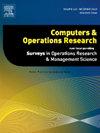超越位置建模与地理信息系统:整合与衔接
IF 4.3
2区 工程技术
Q2 COMPUTER SCIENCE, INTERDISCIPLINARY APPLICATIONS
引用次数: 0
摘要
好的选址决策的重要性不容低估。在许多情况下,这确实是一个生死攸关的问题,无论是在安全和保障方面,还是与商业活动的可行性有关。因此,无论以何种方式考虑空间选择,位置建模在系统理解、设计或扩展中都变得至关重要。位置建模在解决一系列城市和环境背景下的可持续性、弹性、效率和有效性方面也发挥着核心作用。在过去的三十年里,地理信息系统,以及更广泛的地理信息科学,已经成为位置建模的重要补充。本文试图阐明和证明地理信息科学现在是位置建模的核心组成部分,它从根本上连接了地理信息系统和许多方面的优化。GIScience原语是正式结构化和指定的,以便在位置建模的上下文中显式地建立联系。这一点很重要,因为gisscience有助于进一步建立区位理论和原则,这些理论和原则构成了模型扩展的基础,并使人们能够开发更好的解决方法。正因为如此,预计在未来几年和几十年内,位置建模和地理信息系统将继续整合。本文章由计算机程序翻译,如有差异,请以英文原文为准。
Beyond location modeling and GIS: Integration and bridging
The importance of good locational decision making cannot be understated. In many cases it is quite literally a question of life and death, whether in the context of safety and security or associated with the viability of business activity. As a result, location modeling has become essential in system understanding, designing or extension in whatever way spatial choice is considered. Location modeling too is central in addressing sustainability, resilience, efficiency and effectiveness across a range of urban and environmental contexts. Over the past three decades geographic information systems, and more generally GIScience, has emerged as a critical complement to location modeling. This paper seeks to articulate and demonstrate how GIScience is now a central component of location modeling, one that fundamentally bridges geographic information systems and optimization in many ways. GIScience primitives are formally structured and specified in order to make linkages explicit in the context of location modeling. This is significant as GIScience helps to further establish locational theory and principles that form the basis of model extension as well as enables better solution approaches to be developed. Because of this, continued integration of location modeling and GIS is anticipated in the coming years and decades.
求助全文
通过发布文献求助,成功后即可免费获取论文全文。
去求助
来源期刊

Computers & Operations Research
工程技术-工程:工业
CiteScore
8.60
自引率
8.70%
发文量
292
审稿时长
8.5 months
期刊介绍:
Operations research and computers meet in a large number of scientific fields, many of which are of vital current concern to our troubled society. These include, among others, ecology, transportation, safety, reliability, urban planning, economics, inventory control, investment strategy and logistics (including reverse logistics). Computers & Operations Research provides an international forum for the application of computers and operations research techniques to problems in these and related fields.
 求助内容:
求助内容: 应助结果提醒方式:
应助结果提醒方式:


